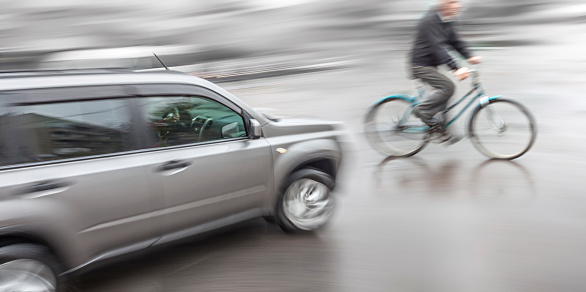Bicycling is a primary method of transportation in Bend. Preventative Oregon laws have been governed to avoid traffic accidents. In 2011, 677 cyclists were killed and an additional 48,000 were injured by automobiles in Oregon. An average of 2 cyclists are killed in the U.S. per day. Accidents can be prevented by following traffic laws.
Laws for Drivers in Oregon
Oregon consolidated the Oregon Driver Manual to prevent collisions. The number of Oregon bicyclists is rising. Give them plenty of clearance when passing and keep road hazards, like potholes, glass, storm grates and litter in mind. The 2018-2019 Oregon Driver Manual automobile laws are listed below.
- Do not drive in a bicycle lane. You may cross a bicycle lane when turning or when entering or leaving an alley, driveway, or private road. Do not move into a bicycle lane in preparation for a turn.
- You may use a bicycle lane as part of an official duty, such as delivering mail. Farm equipment may briefly use a bicycle lane to let other traffic pass.
- You must yield to bicyclists in a bicycle lane or on a sidewalk, before you turn across the lane or sidewalk.
- You must yield to bicyclists at intersections, the same as you do for other types of vehicles.
- When you are traveling at a speed greater than 35 mph, you may only pass a bicyclist by driving to the left when the passing distance is sufficient to prevent contact with the person operating the bicycle if the person were to fall into the driver’s lane.
- Do not honk at a bicyclist, unless you have good cause to warn the rider you are close by. The loud noise could startle the rider. There may be a good reason for the bicyclist to be riding in the travel lane, such as roadway hazards not visible to motorists.
- Operators of motorized wheelchairs, scooters, and personal assistive mobility devices are permitted to use bicycle lanes and paths. These vehicles cannot exceed a speed limit of 15 mph. You must yield to these operators before you turn across the bicycle lane or path.
Laws for Bicyclists in Oregon
Bicyclists are not pedestrians. Cyclists must cooperate with traffic laws. Oregon has developed a collection of state laws for bikers.
- Ride in the same direction as traffic.
- Ride in the bike lane when one is available. You may move into the travel lane to avoid a hazard, turn left or pass. Use caution when entering a traffic lane and yield to traffic.
- Ride no more than two side-by-side on the roadway. Be courteous to following traffic.
- Stop at stop signs. Stop at all red lights and remain stopped until the light turns green.
- Stop for pedestrians at crosswalks.
- Use a white front light and a rear reflector attached to your bike when riding at night. It is also good to wear brightly colored clothing.
- In downtown Bend, bicyclists are not permitted to ride on the sidewalk. While in downtown, ride in the travel lane or walk your bike on the sidewalk.
- When approaching an intersection, be aware of right-turning vehicles.
- Remember to signal all lane changes and turns, including exits from roundabouts.
Call 911 immediately if you are involved with a bike accident. After you identify the nature of your injuries, claim the accident report for medical and financial coverage. Some accidents are settled between the biker and automobilist directly. Serious or more complex accidents may require an attorney. A trained personal injury attorney can help mitigate costs, lost earnings and damages. We recommend always wearing a bike helmet and avoid alcohol. In 2011, intoxication was reported in 37 percent of Oregon’s fatal cyclist crashes. Be courteous when sharing the road.

